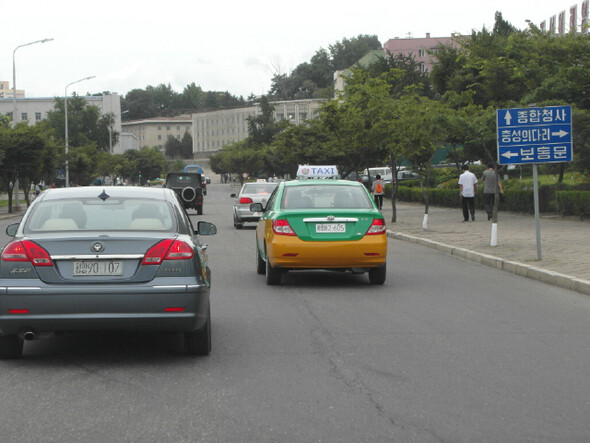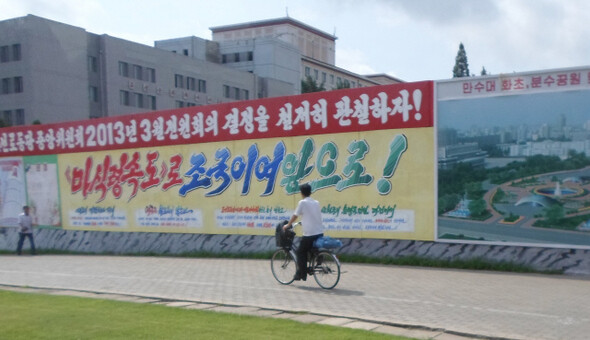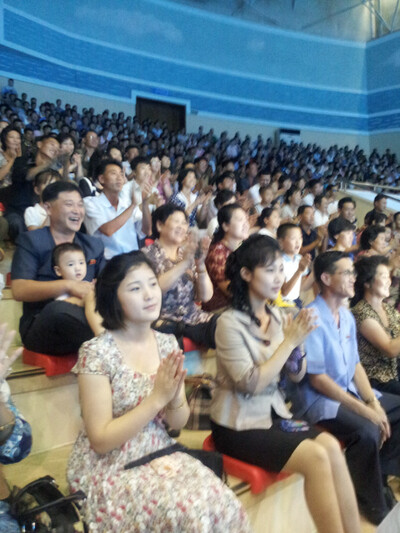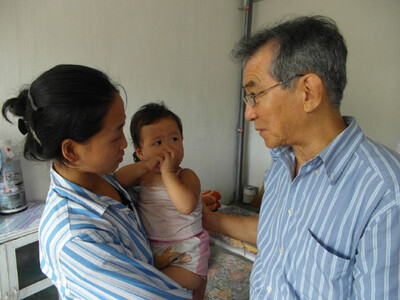hankyoreh
Links to other country sites 다른 나라 사이트 링크
[Special contribution] Pyongyang in the summer of 2013

Gwon Geun-sool, chairman of Okedongmu Children in Korea, visited the North Korean cities of Pyongyang and Nampo with his colleagues from Aug. 14 to 17. Okedongmu is a NGO that has provided humanitarian aid to North Korean children over the past 17 years.
This article describes Pyongyang in summer 2013 as seen through Gwon’s eyes. The eight members of Gwon’s group, including an employee of Seoul National University Hospital, represented the first aid visit to North Korea by a South Korean NGO since Park Geun-hye was inaugurated as president of South Korea.
It had been five years since Gwon had been to the North, and two years since Okedongmu had sent a representative there.
Okedongmu did not receive clearance for their visit from the Ministry of Unification until Aug. 13, the day before they were scheduled to depart. Government authorities had hesitated to grant clearance at all, given the tug of war between North and South that was taking place ahead of the working-level talks on the Kaesong Industrial Complex.
It was clearly evident that the authorities thought carefully about authorizing a civilian aid group to send a group to the North. The purpose of the visit was limited to monitoring baby food for infants and young patients around Nampo. Permission had been given to transfer the food to the North two weeks earlier.
The Okedongmu group learned that an agreement had been reached in the working-level talks over Kaesong as they watched North Korean television the night they arrived in Pyongyang.
By Gwon Geun-sool

■ Mobile phones brought through airport without a hitch
After our rushed departure, all of us were stunned by what happened at Pyongyang Sunan International Airport. The customs personnel at the airport told us that we could take our mobile phones with us.
In the past, the usual procedure was for cell phones to be collected from the group members and returned to them upon their departure from the country. This was not temporary storage so much as confiscation.
But this time, foreign tourists were told that they could call their home country simply by inserting a SIM card in their phones. Of course, we weren’t able to talk on the phone because of network differences, but we were able to take pictures, jot down memos, and play games on our phones.
On the in-flight screen on Air Koryo, North Korea’s only airline, a group of attractive women wearing revealing outfits showing their shoulders sang hearty renditions of popular songs such as “Speak, O Path of Military-First Policies” and “All at Once,” to the tune of instruments. The women were no longer wearing the hanbok, or traditional Korean attire, that we were accustomed to, but rather stage outfits designed to accentuate the female figure.
■ The leisurely streets of Pyongyang
The Pyongyang streets looked more relaxed than we had expected. We did not see any residents tiredly carrying around big bundles as we had several years ago. Instead, there were women passing by carrying parasols. We also saw more buses and taxis.
The buildings and streets of Pyongyang, which in the past had been white and gray, had become more colorful. We noticed buildings with blue-glass exteriors, including the People’s Theater, National Theater, and the multi-function facility known as the Ryugyong Hotel. We also saw several newly constructed circular apartments painted in bright colors. These were sharp modern buildings that would not have been out of place in Seoul.
The Breast Cancer Research Center at Pyongyang Maternity Hospital that the North Korean National Reconciliation Council introduced us to was surprisingly clean and modern. The research institute and hospital are in a six-floor building with 100 patient beds and all of the latest medical equipment.
Across the street, the Central Children’s Hospital was under construction, a facility that will have 300 hospital beds. The army had been brought in, we were told, to build the treatment center for mothers and the hospital for children at “Masikryong speed.”
“Masikryong speed” is a new expression that came into use when North Korean leader Kim Jong-un paid a visit to the ski resort at Masikryong and praised the “soldier construction workers” who had cut through the mountain and built it so rapidly.
The expression is so familiar to North Koreans that we even saw posters saying “Let’s run on the wings of the wind at Masikryong speed.” It struck me how wonderful it would be if the Pyeongchang Winter Olympics could be linked with the Masikryong ski resort.

Perhaps it was because of the Liberation Day holiday - or “Liberation of the Fatherland Day,” as it is called in North Korea - but the area in front of the Rungna Dolphinarium was packed. Located on Rungna Island in Pyongyang, the newly opened park offers dolphin shows to the public. The same day, lines of family members holding hands could be seen at Mangyongdae Funfair, located on the road that leads to Kim Il-sung’s historic home. Painting and service seemed complete on all the rides, and children flocked even to a somewhat rickety-looking Viking ride.
The restaurant at the Yanggakdo Hotel on the Taedong River where we were staying, was packed to capacity in the mornings; at night, tour buses crowded the parking lot in front. Most of the tourists were Chinese, but there were also many visiting from Europe, Canada, and the US with their families. From the hotel, a dredging boat could be seen plodding steadily along the river below.
According to some, all of these changes are a reflection of improvements in recent economic indicators, last year’s rice harvest in particular. It has also been attributed to policy drives by Kim Jong-un, who since coming to power has focused on developing tourist attractions and infrastructure as part of a push for a more “people-friendly” environment.
■ Government: Legacies of Departed Leaders and the ‘Politics of Longing’
Messages of praise for current leader Kim Jong-un were visible all along the streets, and the large statues and the palace enshrining the remains of past leaders were well maintained. The Kumsusan Palace of the Sun, where the bodies of Kim Il-sung and son Kim Jong-il are preserved, lies on the road heading into downtown Pyongyang from the airport. Our guide from the Korean Council for Reconciliation and Cooperation (KCRC, North Korea’s body for civilian exchanges with the South) explained that the name had been changed to from Kumsusan Memorial Palace to “Kumsusan Palace of the Sun”, “to honor Comrades Kim Il-sung and Kim Jong-il as the sun.”
The same big red letters were still plastered throughout the streets. “Comrade Kim Il-sung and Comrade Kim Jong-il are forever with us,” read one message. “Hooray for General Kim Jong-un, the Sun of Military First Choson.” These slogans are the words of the North Korean regime in contemporary times. The towering statue of Kim Il-sung that used to stand alone at Mansudae is now paired with a new statue of Kim Jong-il, showing North Korea’s hereditary transfer of power.
Pyongyang may have transformed itself into a more vibrant city, but the old system of posthumously honoring past leader’s teachings - and the “politics of longing” - is still alive and well.
■ Short on reagent and parts for medical equipmentIt was my first visit to North Korea in five years. Our organization’s aid, which was approved by the Park Geun-hye administration, was already at the Nampo Pediatric Hospital and Nampo Orphanage when we arrived: over 140 tons of flour, powdered milk, and sugar for small children.
We decided to start by checking in on the packages of aid piled up in the buildings’ warehouses and taking photographs for confirmation. The children at the orphanage gave us a hearty welcome, decked out in their nicest clothes despite the broiling heat. Since visits and humanitarian aid to North Korea have been so severely restricted for the past few years, KCRC was very welcoming and helpful to its visitors, never showing even a hint of unhappiness with our requests. They repeatedly thanked Okedongmu Children in Korea for sending medicine and other aid to North Korean children despite the chill in inter-Korean relations, and for continuing to stay in contact with KCRC.
While Okedongmu was doing its monitoring, we took the opportunity to look around the children’s hospital and children’s nutrition research institution where we were supplying aid. On the whole, a lot of the medical equipment had been rendered useless after the lack of aid over the past few years resulted in reagent and replacement parts running out. There was no developing solution for X-ray film, no parts for automated blood analyses, and the endoscopy equipment and patient monitoring systems had fallen into complete disrepair. It was frustrating to witness: equipment that could still be running smoothly if we had visited there a couple times more a year now had to be replaced. Each piece was a reflection of the sponsors’ earnest wishes for North Korea’s children; to see them broken down weighed heavy on our hearts.
Over the years, Okedongmu has consistently said that private exchange and collaboration are needed all the more when the formal channels between authorities are shut down. Our belief is that the only way to build trust is through a complementary, two-track approach of official dialogue at the government level and humanitarian aid at the private level. It’s impossible to shake the sense that halting private exchanges and cooperation over political and military frictions is a really foolish thing to do.
■ Taking pride in wooden doors and bedsThe aid may have stopped, but the hospitals that Okedongmu supported seemed to have established themselves as trusted institutions, with severely ill young patients referred there even from the smaller clinics and university hospitals in the countryside. Doctors at Pyongyang Okedongmu Children’s Hospital prided themselves on cementing their new prestige as a nutrition research center through treatment of an average of 200 cases of diarrhea and malnutrition a day.
According to the director of the Okedongmu Children’s Ward at Pyongyang Medical College, the unit has treated some 4,000 patients a year, many of them children with rare or serious diseases who were referred from smaller clinics and hospitals. The director was especially proud that the ward had saved the lives of more than 1,000 children who otherwise might not have survived.
The roof was open at the center of the building, with metal sheets in place against the elements. In the summer, the heat was overwhelming, and some kind of ventilation system seemed necessary. The unstable electricity supply meant that even with the use of transformers, circuit boards and motors routinely broke down. Planned transfusion facilities, abandoned after the aid stopped, were now being used for other purposes.
At Nampo Pediatric Hospital, which received flour and other aid, construction has been left unfinished for five years. Wood panels had been temporarily positioned in the frames for aluminum shutters, and children lay in makeshift wooden beds. The institutions receiving Okedongmu’s support seemed to be using all of their resources to do the best they could amid the aid drought.

At a final dinner the day before our departure, I delivered some words as Okedongmu’s chairman.
“The first time I visited Pyongyang was in the late ’50s. Here I am today, a gray-haired 73-year-old. The 17 years since Okedongmu was formed have gone by very quickly, but progress in inter-Korean relations has been very slow,” I began.
“I had always said that I couldn‘t imagine 20 to 30 years down the road, when South Korea’s children have become adults and still have to live with the antagonism and tensions, unable to travel between South and North, which are blocked off from each other by barbed wire,” I continued. “Maybe now I should postpone that to about 50 years from now?”
I went on. “Whenever the monsoon rains come in the summer or a blizzard hammers down in the winter, I can’t get those North Korean children out of my mind,” I said. “I wonder: how are they getting through this? Because they are the ones who will soon be the neighbors, the friends and siblings living alongside our children. Caring for children in South and North is the cross the adults of our generation need to bear, no matter how we may struggle under its weight.”
■ Hoping for a recital on the 10th anniversary next yearWe finished up our trip, hopeful that Okedongmu’s visit under the blazing August sun might help spur on further humanitarian exchanges and cooperation. I also imagined a small recital next June, a beautiful and simple affair with children from both North and South at the Pyongyang Okedongmu Children’s Hospital hall for a tenth anniversary celebration. . .
Please direct questions or comments to [english@hani.co.kr]

Editorial・opinion
![[Guest essay] The real reason Korea’s new right wants to dub Rhee a founding father [Guest essay] The real reason Korea’s new right wants to dub Rhee a founding father](https://flexible.img.hani.co.kr/flexible/normal/500/300/imgdb/original/2024/0423/8317138574257878.jpg) [Guest essay] The real reason Korea’s new right wants to dub Rhee a founding father
[Guest essay] The real reason Korea’s new right wants to dub Rhee a founding father![[Column] ‘Choson’: Is it time we start referring to N. Korea in its own terms? [Column] ‘Choson’: Is it time we start referring to N. Korea in its own terms?](https://flexible.img.hani.co.kr/flexible/normal/500/300/imgdb/original/2024/0423/3617138579390322.jpg) [Column] ‘Choson’: Is it time we start referring to N. Korea in its own terms?
[Column] ‘Choson’: Is it time we start referring to N. Korea in its own terms?- [Editorial] Japan’s rewriting of history with Korea has gone too far
- [Column] The president’s questionable capacity for dialogue
- [Column] Are chaebol firms just pizza pies for families to divvy up as they please?
- [Column] Has Korea, too, crossed the Rubicon on China?
- [Correspondent’s column] In Japan’s alliance with US, echoes of its past alliances with UK
- [Editorial] Does Yoon think the Korean public is wrong?
- [Editorial] As it bolsters its alliance with US, Japan must be accountable for past
- [Guest essay] Amending the Constitution is Yoon’s key to leaving office in public’s good graces
Most viewed articles
- 1[Guest essay] The real reason Korea’s new right wants to dub Rhee a founding father
- 2Terry Anderson, AP reporter who informed world of massacre in Gwangju, dies at 76
- 3Why Korea shouldn’t welcome Japan’s newly beefed up defense cooperation with US
- 4[Column] ‘Choson’: Is it time we start referring to N. Korea in its own terms?
- 5Senior doctors cut hours, prepare to resign as government refuses to scrap medical reform plan
- 6Opposition calls Yoon’s chief of staff appointment a ‘slap in the face’
- 7[Column] The clock is ticking for Korea’s first lady
- 8New AI-based translation tools make their way into everyday life in Korea
- 9[Editorial] Japan’s rewriting of history with Korea has gone too far
- 10[Column] Are chaebol firms just pizza pies for families to divvy up as they please?